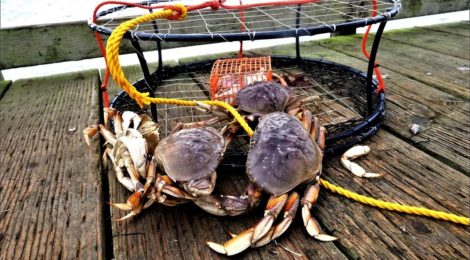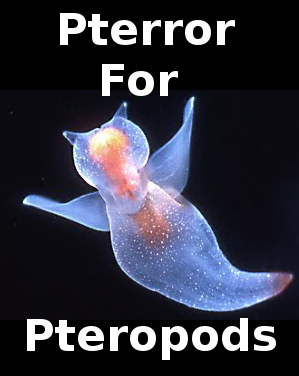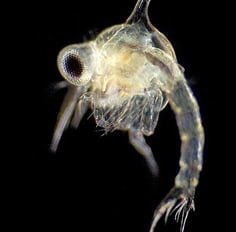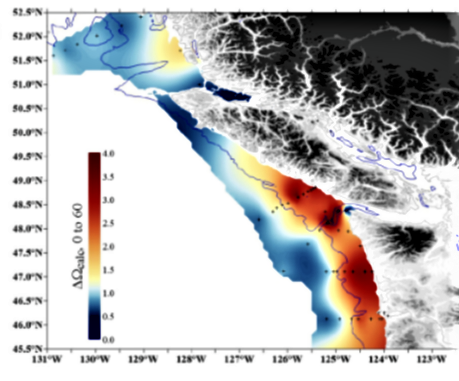
Pacific Ocean Acidification Proves Lethal To Dungeness Crabs
New Report Shows Dungeness Crabs From Alaska To California Are Melting
Well not exactly melting like the Wicked Witch of the West, rather larval crabs can no longer form their first shell
Just ten years ago at an emergency meeting, I attended in Seattle on the shellfish crisis, regional ocean acidification reaching this level of crisis was believed to be at least 50 years away.
The Northwest Marine Fisheries Service just wanted the problem to go away.
The Pacific Ocean has become so acidic due to high and rising levels of CO2 in the atmosphere that crab larvae are dissolving rather than growing. In a new study Dungeness crabs, which have sustained a $220 million industry are a vital part of West Coast fisheries. Their demise from the onslaught of anthropogenic CO2 was believed to be half a century away or more, but it here today. The study was published on January 22 in the journal Science of the Total Environment.

Pteropods are tiny free-swimming snails a quarter of an inch long that drift in ocean pastures, they are tasty and vital escargot for ocean fish especially salmon. Ten years ago badges with this image were handed out to me and other marine scientists attending an emergency meeting in Seattle that was convened to talk about the emerging crisis that was killing the Pteropods already but was sure to threaten larger shellfish.
Ocean acidification is an early problem on the Pacific Coast due to the prevailing onshore winds that drive ocean waters onto the coast. This produces an upwelling of deep waters where the natural concentration of CO2 is normally much higher than the surface ocean waters.
Before the fossil fool age drove atmospheric levels of CO2 to the levels almost 50% higher than a century ago the more acidic deep waters readily diluted their corrosive water into the far less acidic surface waters. But now the difference between the less acidic surface and more acidic deep water is insufficient and the end result all the waters near shore have plunged to levels of acid that is killing the most vulnerable marine life.
Big tough marine life such as oysters, mussels, and adult crabs are tough enough to resist the acid attack. But those shellfish have a life cycle where they hatch from nearly microscopic eggs as soft-bodied drifting larvae. In the first few days after hatching the larva must begin to capture the calcium from the water and make their first protective shells. They have little energy to do this with, just the remains of the yolk from their life as an egg. In this super vulnerable state they are lost in today’s oceans of just slightly more acidic water.

Dungeness crabs start life as tiny larvae, it is in this stage where the more acid ocean they now live in prevents them from getting enough calcium to make their shell. They just die.
The authors of this new report collected the data in 2016 while aboard a National Oceanic and Atmospheric Administration (NOAA) research cruise. Scientists caught larval-stage Dungeness crabs from 10 different coastal regions and recorded information for each location, including its temperature, depth, and acidity. Back in the lab, Bednaršek and her team looked at the crabs under high-powered microscopes, a process that could take up to half a day for a single 1 centimeter-sized crab.
Their attention to detail paid off: Scientist Nina Bednaršek noticed that crabs from more acidic sites tended to have partially dissolved exoskeletons, in the most extreme cases on both the outer and inner sides.
“There are some stations where the crabs are there and they look really compromised,” Bednaršek said. “I started immediately thinking, Wow, if I see this kind of impact now, how is this going to look like in 10 years’ time?”

Pacific Northwest Coast Ocean Acidification Crisis, red regions show deadliest acid waters.
Dungeness crabs are just the latest additions to the list of organisms harmed by ocean acidification. Bednaršek has studied pteropods—marine snails known as sea butterflies—and has found that acidification causes their shells to dissolve, too. One difference between these sea creatures, though, is that until this study, scientists had not thought to study larval Dungeness crab shells and were certain that adult crabs could not dissolve.
As ocean acidification affects the availability and survival of Dungeness crabs, people can harvest crabs from less acidic regions of the coast or at different points in the season when acidification is not as pronounced, Bednaršek said. But humans will have to make big, sustained changes to keep from continuing down a harmful path: The study found that the past two decades of ocean acidification alone have led to a 10% increase in the dissolution of the crabs’ shells.
“It’s kind of like a wake up call,”Bednaršek said. “We still need to start seriously thinking what to do in terms of not just adaptation, but mostly mitigation, like how can we start reducing these fast changes in the natural environment that are happening in front of our eyes.”
In Pacific Northwest shellfish farms that grow oysters and clams mitigation was introduced 10 years ago in the form of ocean acidity monitoring equipment provided by the Northwest Marine Fisheries Service to shellfish growers. The growers were advised to be able to respond to episodes of acid waters by adding neutralizing agents to the vital larval nurseries for their shellfish crops.

We are the culprits, know your carbon footprint and do everything you can to reduce it.
But for Dungeness crabs these are not farmed but rather are the wild stocks that are harvested in ‘crab traps’. The industry has banked on the crabs being able to reproduce and provide the never-ending supply for them to trap. Those natural crab populations are also vital in the ecosystem as they are the scavengers on the seafloor and work to keep the ocean healthy. Now the crabs future appears to be certain doom with the culprits being not the usual suspects in marine fisheries declines those overfishing fishermen. The culprits in the case of Dungeness Crabs and countless other forms of marine life is each of us and C02 that we and our families are responsible for emitting from our ravenous appetite for boundless energy for cars, trains, and aeroplanes.
There is hope however that ocean acidification might be beaten back by the Nature-based solution of ocean pasture restoration, OPR. Our fossil CO2 dissolves into ocean waters readily. When it does the natural chemistry adds CO2 + H2O to make H2CO3, that’s carbonic acid the stuff that is melting the baby crabs and other shellfish. The only means to neutralize it is by restoring the health and abundance of our ocean pastures. Those pastures sustain the phytoplankton, the grass of the sea. When healthy and abundant phytoplankton uses the power of the sun through photosynthesis to compete with the H2O for that CO2. They always win and convert that acid-forming CO2 into ocean plankton the very thing that feeds larval crabs and shellfish.
When in abundance ocean phytoplankton pastures feed all of ocean life by repurposing our deadly CO2 into new life itself. You can read everywhere on this blog how we have proven we can restore ocean pastures and save our seas from our sins of emissions.








